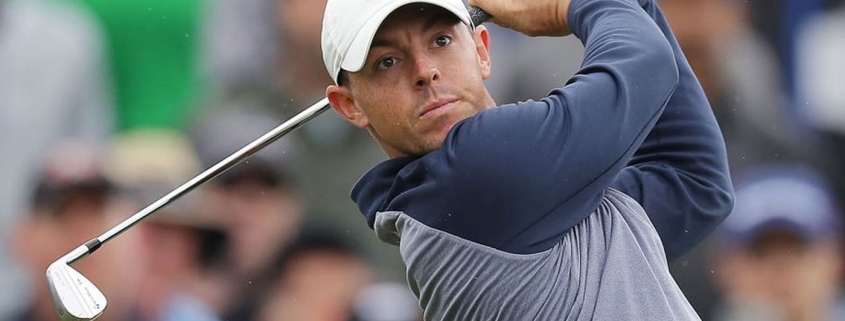McIlroy Wins Players, Furyk Contends
On a tough weather day on a difficult golf course, Rory McIlroy used his new found “poise and patience” to win the 38th edition of The Players Championship contested at the TPC at Sawgrass Stadium Course. A missed birdie putt on two and an unheard of double-bogey six on number four could have derailed McIlroy’s day, but said he called on recent failures to get him to the finish, “One shot at a time.” Even he knew it was a cliché’.
With a real game plan and the ability to execute it, Jim Furyk put up a -15 score for everybody, including McIlroy to look at coming through “The Gauntlet” as the players call the final three finishing holes of Pete Dye’s design.
His 7-iron from 171-yards on 18 led to a short birdie putt that allowed him to post 15-under and wait. “I was just real comfortable over the ball on that shot,” Jim told me walking to the press room. “I usually hit 7-iron 172, I know that’s a weird number but I was trying to land it 167 and let it roll up. It was hard to judge how much the wind was hurting.”
McIlroy’s birdie on 15 was the decisive shot as it buoyed his confidence going to the final three holes. A two-putt birdie on 16 gave him a one shot lead and the thought “just three more good swings” would give him the title. He made those three swings and an easy two putt par on 18 made him the 2019 Players Champion.
Add Rory’s name among the best players of their eras to win in North Florida as this year’s tournament marked the 55th consecutive year of a big-time professional golf tournament in North Florida.
There’s a colorful history of professional golf in Jacksonville. In 1947 Ben Hogan made a famous 11 on the par 3 sixth hole at Hyde Park during the Jacksonville Open. Legend has it that’s when he uttered the now famous retort when asked how he made an eleven. “I missed a four footer for ten.”
That tournament took an eleven-year hiatus starting in 1954 before being resurrected in 1965 by “three or four guys sitting at Silvers Drug Store” according to two of the tournament founders, John Tucker and Wesley Paxon. Silvers Drug was at the corner of 3rd street and Atlantic Boulevard in Neptune Beach. “Mr. Silver would open up at 5AM and put on a pot of coffee for us to meet.”
At 95 years old, Paxon played nine holes last Sunday. Nowhere near the “two or three” he once was, but still enjoys playing and watching the game. It was his germ of an idea that created the momentum for what The Players is now, fifty-five years later.
“I called Tucker and tried to upgrade the Gator Bowl Pro Am,” Paxon said this week from his home in Ponte Vedra. “And the next thing you know, we had a tournament.”
If only it were that easy.
Tucker, who will be 90 in July, also played as “a three most of my life” and still plays nine holes once or twice a week.
“Wesley got me interested in the Gator Bowl,” Tucker started to explain. “They had started the Pro Am and it wasn’t going anywhere. In 1963, Wesley called me and said he was going to be president of the Gator Bowl and asked if I couldn’t get a big name, Palmer or Nicklaus to play in this thing.”
Running the operations in Jacksonville for Southern Bell, Tucker had an advantage for the early ‘60’s: free-long distance calling.
“People wouldn’t believe this today,” Tucker recalled, “But you only used long distance for emergencies. I’m the manager of the telephone company so Wesley says to me ‘You can call free, call around and see if you can get some players.’ So I started making some calls.”
When the first “super-agent” Mark McCormack gave Tucker the price for Palmer or Nicklaus, John knew he had to look elsewhere. He called Jim Gauqin from the PGA of America in New York and asked for help finding players. The PGA was running tournaments before the creation of the PGA Tour and Gaquin admitting he was having problems with the tournament in St. Petersburg.
“He was on his way to St. Pete,” Tucker remembered, and I invited him to stop off here and he came.”
Gaquin liked Tucker and Jacksonville, the new Deerwood course and Selva Marina. “I told him if that doesn’t work out in St. Pete, bring them up here.”
When things fell apart in St. Pete Gaquin called Tucker to ask if he really wanted the tournament. To do so, Gaquin explained, they’d have to offer a $50,000 purse, double the going rate. Undaunted, Tucker said yes.
“Where are we going to get $50,000? Tucker recalled thinking.
And that’s where the business owners, sports fans and golf enthusiasts came into play.
“Prime Osborn and Tom Rice ran the paper and they had just hired Bob Feagin as their VP from SWD,” Tucker explained. “I told him this was a chance to get this community behind the Times Union. They liked it and put up the money.”
But that was only the first step. Tucker and Paxon sat down with guys they played golf with from around the city to talk about organizing the tournament. They had a blueprint provided by the Pensacola pro tournament’s Sam Love, Tucker’s counterpart with the phone company from Pensacola.
“John Montgomery, Sonny Miller, Gene Cowan, Lester Varn from Timiquana, D.K. Brown from Selva all were guys we knew who could get their clubs involved. I knew Brown because he was head of the FBI here in Jacksonville. I knew him because when he wanted a wiretap, he had to talk to me. He got the tournament to Selva.”
They had meetings at the George Washington and Roosevelt hotels downtown. But at the meetings the lower your handicap, “The more influence you thought you should have.”
They hired Paul Warren from Toledo to do the nuts and bolts operation of the tournament. Then they started calling their friends.
“I called Jim Taylor the president of Capital Concrete and told him the kind of stakes I needed to rope the golf course. He made them and gave them to us. Everybody called on their best friends. Port-a-lets, rope, printing, all of it was donated. You give us this; we’ll give you tickets. A lot of people in town felt ownership. Billie Nimnicht gave us cars, there were150 different organizations involved and felt like they had ownership.”
“Brining in your friends was a new concept,” Paxon explained. “Getting the community involved. My electric company had the 18th hole for 20 years. We were proud of that. We had the newspaper, the banks, the railroad. They were all local people. Those people all helped us.”
If there was a missing piece, Tucker found it in Dick Stratton. Stratton, along with Virginia Atter Keys, was the first television star/celebrity/personality in Jacksonville. He reached across the whole city from his spot as a TV host and Master of Ceremonies nightly.
“All of us had a few friends,” Tucker explained. “Everybody thought they knew Dick Stratton and he knew everybody. The audience was magnified. He brought us an audience that none of us could have produced. He took our dreams and verbalized them where everybody had ownership and made it feel like they were a part of it. Without him, it would have taken years to get that out.”
The tournament re-started in 1965 with a volunteer force that caught the eye of the first PGA Tour commissioner Joe Dey. Dey called Tucker and wanted to come to Jacksonville to see why the players wanted to come here.
“We had shopping trips for the wives, free day care, free babysitting and the players loved it,” Tucker explained. “Deane Beman came down and saw the tournament organization when he was looking for a permanent home for the Tour. He liked how different people in town had ownership.”
After a stint as the general manager at the Times Union, Tucker was called back by Beman to run the tournament again in1983. And he might have had a hand in the corporate hospitality that’s prevalent, and a moneymaker, for golf tournaments worldwide.
“I ran into a group from England on a trip to New York who fed the players at Wimbledon and they told me what they could do. They put on a white tablecloth, silver service dinner in a tent. We always hosted all of the tournament directors during TPC and when I told Deane we were going to hold the dinner in a tent on the golf course he said, ‘Is this going to work?’ It did and we started selling corporate hospitality tents right away.
Admitting the tents they put up were pretty funny looking by today’s standards, Buick was the first to paly $20,000 for their own chalet, brining in clients from North and Central Florida and eventually from around the country.
“Pete Dye and Beman designed the course with spectator mounds for people to sit on,” Tucker said. “We just helped that along.”
And what will John Tucker see when he watches the final round on television today from his home in San Marco?
“Damon Olinto grew up in my backyard with my kids,” he said. “When he was chairman last year he took me out there. Everything was smooth and beautiful but the people to people communications is still the same. The fun they volunteers are having. Every hole, the marshals want to make their hole the best. That’s what makes it great, the people.”
In fifty-five years, the tournament has grown, the PGA Tour has spent tens of millions of dollars to make it their showcase, but Tucker and Paxon believe the people in North Florida are the cornerstone of the success of The Players.
“We were just three or four guys sitting in Silvers trying to find out what we’re going to do that day,” Tucker explained. The people now running the tournament know how to find the solutions. They can call on past tournaments and fix whatever problem they have. It’s beyond anything we ever dreamed of. But every year the volunteers and the new chairman want it to be the best ever. That really makes it special.”
“It’s on the same level as it was 60 years ago,” Paxon added of the volunteer enthusiasm. “It was the anchor of what it was and what it is today.”
“I think America comes to mind,” Paxon added. “Only in America could something like that happen. You start in a drugstore and now it’s worldwide. It’s because of the kind of people we are and the kind of people who live here.”
“It’s no longer a Model T,” Tucker said with a laugh. “It’s a magnificent machine. They call it the Gold Standard. I think that aptly names what it is.




